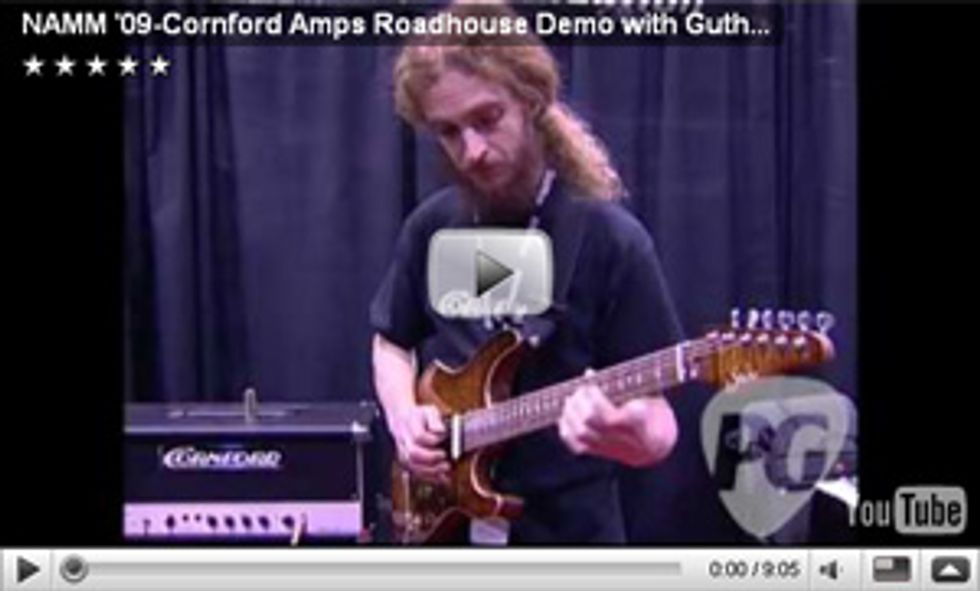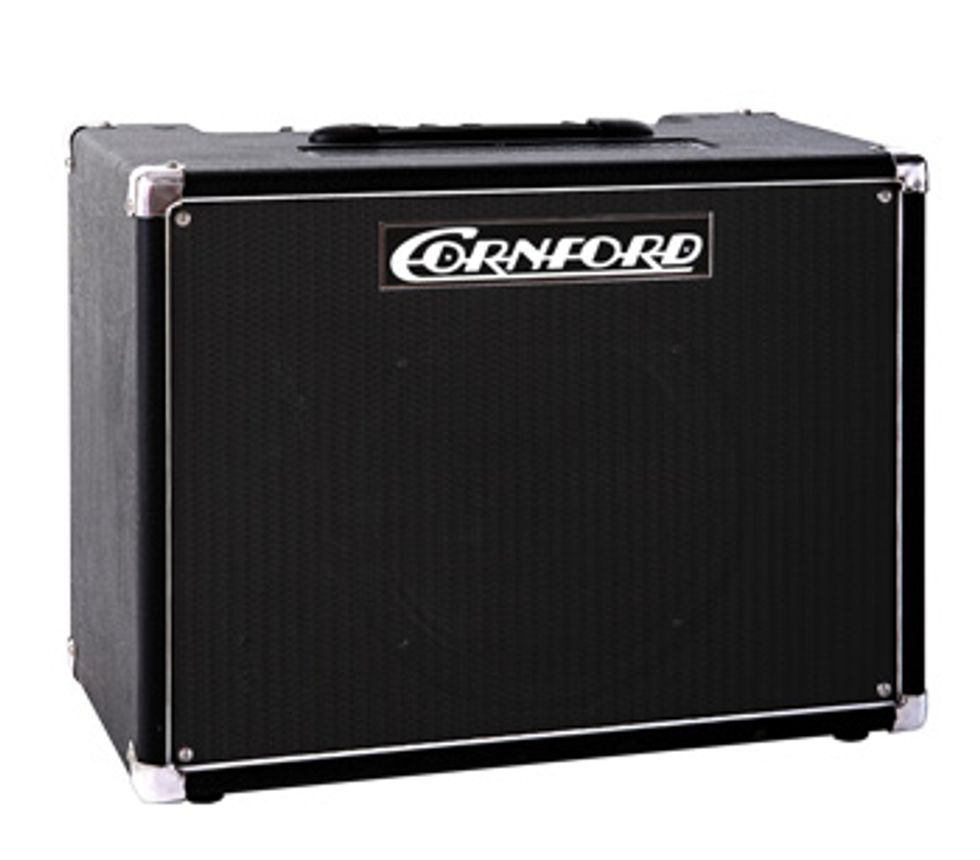The Cornford Roadhouse 30 is a portable, affordable option for rock
Watch Guthrie Govan play the Cornford Roadhouse 50: |
Set ‘em Up
Digging in, the first thing that caught my eye was the Celestion Vintage 30 speaker, which carries an 8-ohm rating. The tube compliment is also impressive: two EL34s and three 12AX7s. Usually in a 30-watt amp we’d expect to see EL84 type tubes, but the EL34 is less noisy and has a better life expectancy. The amp is cathode biased, rather than fixed bias, which is partly responsible for the lower wattage it produces (Cornford’s 50-watt version is fixed bias, and carries the same tube compliment).
 Starting left on the control panel, we have the Input jack, which is 1 megohm, optimal for electric guitar usage. Next is Gain, a small toggle switch for activating the Boost feature, the Boost control, and Bass, Middle and Treble tone controls. This is followed by the Send and Return jacks for the effects loop, and the Master Volume control and On/Off/Standby switch.
Starting left on the control panel, we have the Input jack, which is 1 megohm, optimal for electric guitar usage. Next is Gain, a small toggle switch for activating the Boost feature, the Boost control, and Bass, Middle and Treble tone controls. This is followed by the Send and Return jacks for the effects loop, and the Master Volume control and On/Off/Standby switch. The rear panel features an IEC-type mains inlet socket, high-tension fuse holder, and 5speaker jacks: one 16-ohm, two 8-ohm and two 4-ohm loads. I have always preferred this type of impedance switching, as opposed to the rotary or switch type. Direct connection to the transformer taps is more reliable. At the end of the back panel is the footswitch jack for the one-button Boost switch, which is provided with the amp. It overrides the switch on the front panel.
Knock ‘em Down
I have to say I was pleasantly surprised when I first fired up the amp. I always start with Tone and Gain controls all on twelve o’clock. I used my trusty Les Paul Custom with original ‘50s PAF pickups first. The tone was warm and very bluesy, reminiscent of very early Clapton tone with a sweet, smooth overdrive and just the right amount of harmonics. I had discovered a killer blues amp and I hadn’t even turned a knob yet. The tone controls sweep through a wide range, much like other Cornford amps I’ve played, and it was easy to dial in the tones I wanted.
I could not resist the urge to grab a 1959 Les Paul Standard that was lurking nearby and plug it in—I could have played that combination all day. Back with my LP Custom, I experimented with the gain settings, and I found that this control was very active. Most of the higher gain started to come on about three quarters to full on. Lower gain settings yielded a nice sparkling tone similar to a Vox AC30 or 50—great for Strat-type tones. The Roadhouse loves single coils as well as humbuckers, and the Boost control really put it over the top. It’s got a very controllable gain that cleaned up when I lowered the guitar’s volume. This also worked even on maximum gain settings.
This amp is extremely touch-sensitive; the tone controls were my fingers. On some amps, a note picked firmly and then softly produces different volumes. On a good touch-sensitive amp such as this one, it produces a different tone. The same thing occurred when using the Strat, which was a simple American Standard model. Sparkling notch-position tones to heavier Robin Trower-type tones came easily. The power section with the EL34s really had just the right amount of sag to it. It remained tight on the low end for percussive faster passages but was still bluesy enough for soulful Billy Gibbons licks.
A single-button footswitch is provided with the amp. I found this to be very useful, because I could put the master volume on full up and treat the boost like an onboard Tube Screamer, which worked out well. The effects loop is the standard series type. It worked well with most of the pedal effects I tried. If you want to use another preamp, the effects loop can be used as an input for that as well.
The Final Mojo
I found the Cornford Roadhouse 30 combo to be a great amp for those looking for a professional-quality tone without the weight. It’s a small package with a big tone, and it would serve the needs of almost any type of guitarist. Whether it’s blues or screaming, harmonic-laden riffs, this amp seems to do it all very well. It is very pedal-friendly—overdrives, rangemasters and other types of boosts work quite well.
Buy if...
a reasonably priced, lightweight screamer is what you need.
Skip if...
you need high power and a 4x12 cabinet for your style of music.
Rating...
MSRP $1499 (combo); $1399 (head) - Cornford Amplification - cornfordamps.com - cornfordusa.com |


